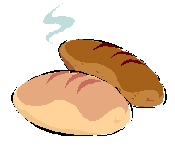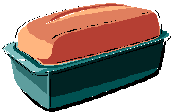|
Tricks of the Trade -- Tips and Techniques of the Home Baker
 Beyond ingredients, the process of bread making is an art in itself. I've divided the processes of this art into the steps followed by home bakers, searching out those little hints that will make your artistic endeavor enjoyable. Beyond ingredients, the process of bread making is an art in itself. I've divided the processes of this art into the steps followed by home bakers, searching out those little hints that will make your artistic endeavor enjoyable.
The following topics are discussed on this page. Click the links below to jump to the section you want:
Mixing
Kneading
Rising
Shaping
Toppers
Baking
Storage
Mixing
Mixing distributes the yeast and moistens the flour, starting the process of gluten development. You can see, then, that thorough mixing would be important for good bread. To keep the flour from lumping up, you can mix the dough with an electric mixer until it becomes too stiff; then continue stirring and mixing in the flour by hand. Adding a small amount of flour (1/4 cup) at a time and stirring until it is completely moistened will aid in good gluten development and ensure that the yeast is evenly distributed.
You can also use the "well" method to mix the dough. Place the minimum amount of flour from the recipe into a large bowl and stir in the other dry ingredients. Dig a well in the center. Stir the dissolved yeast and other liquid ingredients together. Pour into the well. To mix the dough, draw the flour from the sides slowly into the liquid center and mix thoroughly. Continue drawing the flour until the batter is smooth and thick, adding more flour as needed until the dough just cleans the sides of the bowl. Turn out to knead. It can still be runny at this point. You'll add the remaining flour in the kneading process.
One other method used for even yeast distribution and gluten development is termed the sponge method. This method makes dough firm, yet supple, and easier to handle. It also has the advantage of working around your schedule. You can make the sponge, leave it to ferment for a few hours, then come back and finish off the bread when time permits. For the sponge, follow the well method above, only using 1/2 to 3/4 of your recipe's flour requirement, all of the yeast (though if you add less, you can leave the sponge to ferment longer), part of the sweetener (a pinch), and enough liquid to make a thick, smooth batter. Never add the salt or fat to the sponge. Pour the liquid into the well center and mix or whisk in the flour to form the thick, smooth batter. Then sprinkle some of the flour over it to keep a skin from forming. Cover loosely, and let it sit for at least 20 minutes or until bubbly (sometimes overnight) . Mix in the remaining flour, salt, and liquid from the recipe to form dough that just cleans the sides of the bowl. Continue to the kneading step.
Kneading
 When making bread by hand, under-kneading seems to cause the most problems. When making bread by machine, over-kneading is often the culprit. How can you tell if your dough needs more kneading? The Fannie Farmer Cookbook (6) states that if you rest your palm for 30 seconds on dough that is adequately kneaded, the dough will not stick to your palm after it is removed. Keep in mind, though, that whole-grain dough is always a bit more tacky than that made with all-purpose flour. Expect some sticking after running the palm test on it.
When making bread by hand, under-kneading seems to cause the most problems. When making bread by machine, over-kneading is often the culprit. How can you tell if your dough needs more kneading? The Fannie Farmer Cookbook (6) states that if you rest your palm for 30 seconds on dough that is adequately kneaded, the dough will not stick to your palm after it is removed. Keep in mind, though, that whole-grain dough is always a bit more tacky than that made with all-purpose flour. Expect some sticking after running the palm test on it.
I think a timer is still the surest way of kneading adequately by hand, at least until experience teaches you what properly kneaded dough looks and feels like. Knead white-floured dough for about 5 minutes per loaf, and work whole-wheat dough for 8-10 minutes per loaf. It is difficult to over-knead dough by hand, so even if your arms are aching, keep on until the timer beeps, or enlist a helper to knead for you while you take a breather.
"But how do I knead?" some may ask. As Beth Hensperger (5) put it, "Some push, some press, some squeeze, some slam. Some are gentle, others are vigorous." As you can see, anything goes. Of course some methods may take longer to develop the smooth, elastic, blistery-just-under-the-surface dough. The best way to learn to knead is to watch someone do it. But if that isn't possible, here's my best description: Push out the dough with your palms, fold it in half by bringing the top towards you, and then push it away from you again while giving it a one-quarter turn clockwise. Repeat these steps until your dough passes the palm test.
Finally, what is the purpose of kneading? It helps develop the gluten framework. The higher the protein content of the flour used, the longer it takes to develop that gluten (i.e. more kneading required). Avoid adding more flour than necessary when kneading. Just sprinkle a bit on the dough and on the kneading surface to keep it from sticking to your hands and the counter. Adding too much flour results in dry and crumbly bread. You've heard that the weather can affect bread? The humidity determines how much flour you'll have to add. If it is dry, you'll add less, and if it's humid you'll add more. Snow days are dry days, so you'll need less flour.
Rising
Time to let that beautiful dough rise and shine! Grease the bowl lightly with shortening. Place the kneaded dough into the bowl and flip it over. The top should now be coated with shortening. It's really important that the dough not dry out while rising. Cover the dough with a damp tea towel (make sure the bowl is big enough that the bread won't rise into the towel and become one with it), lid, cookie sheet, or plastic wrap lightly coated with cooking spray, etc.
Different opinions abound as to the best rising place. I've proofed dough successfully in almost every spot in my kitchen and at about every temperature from 68 to 85 degrees F. Obviously, the cooler temperatures require more time to complete the process. Scientifically, the best temperature for yeast working conditions is between 80-85 degrees F. Draft free and potentially warm, ovens are suitable places for proofing. The pilot light in a gas oven usually puts out enough heat to maintain an 80-degree area. In an electric oven, turn the heat to the lowest setting for a few minutes. Then turn it off. Place a pan of warm water on the bottom rack with the bowl of dough above it for either type of oven. Yeast adores that moist warmth.
Test the dough to see if it has risen enough by inserting your finger gently into the top about 1/2-inch deep. If the hole begins to fill in, the dough still needs to rise. If the dough collapses, OOPS! If the indentation remains, punch down the dough with a fist in the center. Then fold the sides over. Let the bread relax for about 10 minutes for easier shaping. Divide and get ready to roll.
If you are not ready to shape and bake the bread, you can refrigerate the dough or let it rise again. Keep in mind that the more the dough rises, the more the yeast cells weaken, releasing glutathione, which damages the protein framework and can lead to flat bread. For good flavor with a good rise, limit the total times the dough rises to three, twice before shaping and once after.
Shaping
 As much as possible, avoid adding flour during the shaping process. The yeast has already fermented the flour and adding more will just make the dough tough. So, instead of placing the dough on a floured surface for shaping, grease the countertop lightly with shortening. Use a light coating of shortening on your hands and/or rolling pin, as well.
As much as possible, avoid adding flour during the shaping process. The yeast has already fermented the flour and adding more will just make the dough tough. So, instead of placing the dough on a floured surface for shaping, grease the countertop lightly with shortening. Use a light coating of shortening on your hands and/or rolling pin, as well.
Just as in kneading, there are myriad ways to shape loaves of bread. Click here to get some ideas on how to shape rolls (Video courtesy of Cook'n with Pillsbury). The easiest loaf requires little more than punching the dough into a tight ball to remove air bubbles before dropping it into the center of a greased loaf pan. Alternatively, you can roll the dough out into a rectangular shape and then roll it up tightly from the short end. Pinch the closing seam tight against the roll and tuck the ends under to fit into the loaf pan. If you rolled the rectangle from the long side, you'd enjoy a French-looking loaf.
And, then there's a free form loaf. Instead of baking in a loaf pan, roll the dough gently into an oval, crease it in the middle, and roll one side atop the other into a fat egg-shape. Fold the short ends under and pinch all the seams to seal. Place on a greased baking sheet with the seam down.
Click here to see a new twist on bread; Two-Tone Twist Loaves (Video courtesy of Cook'n with Pillsbury).
To grease pans, avoid using plain oil. The dough will absorb it and stick to your pan. Instead, rub the pans lightly with shortening, spray with non-stick coating, or brush with a thin coat of lecithin/oil mixture (1 part lecithin to 2 parts vegetable oil; store in refrigerator).
Toppers
 After shaping, you can slash the dough attractively, glaze, or add decorative toppers. You can also add these just before putting the dough into the oven for baking, but do it carefully so the dough doesn't deflate. Click here to see how to add toppings to Focaccia Bread (Video courtesy of Cook'n with Pillsbury).
After shaping, you can slash the dough attractively, glaze, or add decorative toppers. You can also add these just before putting the dough into the oven for baking, but do it carefully so the dough doesn't deflate. Click here to see how to add toppings to Focaccia Bread (Video courtesy of Cook'n with Pillsbury).
Slashing: Mostly beautiful, sometimes functional, slashing can be the trademark of your bread. Use a sharp knife to make one long cut down the middle, or small slashes across the loaf, three-inches apart, criss-crosses, checkerboards, or any other design solely yours. Hold the knife at an angle to slice the loaf, instead of straight on, unless slicing down the middle. This will help the slash open up and brown prettily. Slash from 1/2-inch to 1-inch deep.
Glazes: For shine, flavor, or crispness, brush on these glazes with a soft pastry brush. A bristly brush may pierce your beautifully risen dough, so use caution. You can brush on the glaze before, during, and after baking. If glazed before, brush on more glaze at the mid-point of the baking time. Apply two thin coats rather than one thick one, and be sure to avoid glazing the sides of the pan. It may catch the dough and prevent it from rising in the oven.
# Egg wash: 1 egg white, 1 tablespoon water, 1 teaspoon (or less) salt (only brush this on before/during baking)
# Plain water (crispy crust)
# Milk or cream
# Olive oil (herb-infused)
# Salt water
# Molasses Glaze: 1/2 tablespoon molasses, 1 tablespoon water
# Sugar Glaze: 2 tablespoons sugar, 1/4 cup water
Toppings: Apply these after glazing or by rolling the dough in them directly after shaping. Some burn easily so be prepared to cover with foil or reduce the oven temperature. Sprinkle powders through a sieve for even distribution.
# Cornmeal
# Cracked wheat
# Flakes (barley, oat, rye, wheat, 9-grain cereal)
# Flour
# Fresh minced herbs
# Grated cheese
# Oats soaked in milk (crunchy)
# Sea salt
# Seeds (anise, caraway, flax, poppy, sesame, sunflower)
Baking
 If your oven gives you fits, invest in an oven thermometer to take the guesswork out of temperatures. Preheat the oven and place your bread gently onto the racks. If baking more than one loaf, leave adequate space between pans and the oven sides for good air circulation. A hot oven (400-degrees F.) kills the yeast quickly and creates that desirable crispy crust. Usually after the first 10-15 minutes, the oven temperature is reduced to prevent over-browning. Avoid checking or glazing the bread until after this initial baking period.
If your oven gives you fits, invest in an oven thermometer to take the guesswork out of temperatures. Preheat the oven and place your bread gently onto the racks. If baking more than one loaf, leave adequate space between pans and the oven sides for good air circulation. A hot oven (400-degrees F.) kills the yeast quickly and creates that desirable crispy crust. Usually after the first 10-15 minutes, the oven temperature is reduced to prevent over-browning. Avoid checking or glazing the bread until after this initial baking period.
Rotate the bread as needed to evade hot spots if the bread is browning unevenly. If the crust is darkening too fast, cover the loaf with foil, shiny side out. When done, the bread will sound hollow if tapped with your knuckles on the bottom crust. If you just hear a dense thud, return the loaf to the oven , directly on the racks if desired, and continue baking for 5-10 more minutes.
Remove the bread immediately from the pans onto a cooling rack to prevent a soggy crust.
Storage
Cool the bread completely before storing. If you can't eat a loaf in more than 2-3 days, wrap it in plastic wrap and keep it in the refrigerator to prolong its life span. You can freeze loaves, wrapped air-tightly in heavy plastic wrap and aluminum foil or in freezer bags, for up to 3 months. When ready to serve, remove from the freezer and thaw at room temperature (about 3 hours) to let the bread reabsorb any melting ice crystals. In a hurry? Thaw a loaf in a 325-degree F. oven for 15-30 minutes. Remove the plastic wrap first!
* DVO welcomes your kitchen hints and cooking or nutrition questions! Email us and we'll post your hints and Q/A's in upcoming newsletters! *
|










 Beyond ingredients, the process of bread making is an art in itself. I've divided the processes of this art into the steps followed by home bakers, searching out those little hints that will make your artistic endeavor enjoyable.
Beyond ingredients, the process of bread making is an art in itself. I've divided the processes of this art into the steps followed by home bakers, searching out those little hints that will make your artistic endeavor enjoyable. When making bread by hand, under-kneading seems to cause the most problems. When making bread by machine, over-kneading is often the culprit. How can you tell if your dough needs more kneading? The Fannie Farmer Cookbook (6) states that if you rest your palm for 30 seconds on dough that is adequately kneaded, the dough will not stick to your palm after it is removed. Keep in mind, though, that whole-grain dough is always a bit more tacky than that made with all-purpose flour. Expect some sticking after running the palm test on it.
When making bread by hand, under-kneading seems to cause the most problems. When making bread by machine, over-kneading is often the culprit. How can you tell if your dough needs more kneading? The Fannie Farmer Cookbook (6) states that if you rest your palm for 30 seconds on dough that is adequately kneaded, the dough will not stick to your palm after it is removed. Keep in mind, though, that whole-grain dough is always a bit more tacky than that made with all-purpose flour. Expect some sticking after running the palm test on it. As much as possible, avoid adding flour during the shaping process. The yeast has already fermented the flour and adding more will just make the dough tough. So, instead of placing the dough on a floured surface for shaping, grease the countertop lightly with shortening. Use a light coating of shortening on your hands and/or rolling pin, as well.
As much as possible, avoid adding flour during the shaping process. The yeast has already fermented the flour and adding more will just make the dough tough. So, instead of placing the dough on a floured surface for shaping, grease the countertop lightly with shortening. Use a light coating of shortening on your hands and/or rolling pin, as well. After shaping, you can slash the dough attractively, glaze, or add decorative toppers. You can also add these just before putting the dough into the oven for baking, but do it carefully so the dough doesn't deflate. Click
After shaping, you can slash the dough attractively, glaze, or add decorative toppers. You can also add these just before putting the dough into the oven for baking, but do it carefully so the dough doesn't deflate. Click  If your oven gives you fits, invest in an oven thermometer to take the guesswork out of temperatures. Preheat the oven and place your bread gently onto the racks. If baking more than one loaf, leave adequate space between pans and the oven sides for good air circulation. A hot oven (400-degrees F.) kills the yeast quickly and creates that desirable crispy crust. Usually after the first 10-15 minutes, the oven temperature is reduced to prevent over-browning. Avoid checking or glazing the bread until after this initial baking period.
If your oven gives you fits, invest in an oven thermometer to take the guesswork out of temperatures. Preheat the oven and place your bread gently onto the racks. If baking more than one loaf, leave adequate space between pans and the oven sides for good air circulation. A hot oven (400-degrees F.) kills the yeast quickly and creates that desirable crispy crust. Usually after the first 10-15 minutes, the oven temperature is reduced to prevent over-browning. Avoid checking or glazing the bread until after this initial baking period.